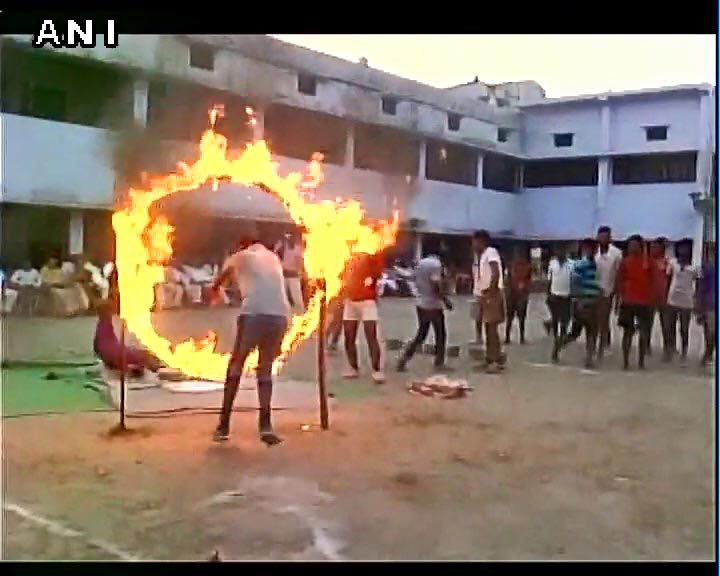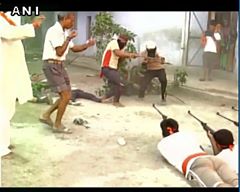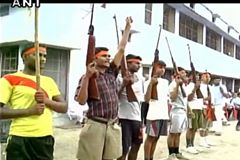Image Courtesy: Aaj Tak
In what appears to be a clear-cut exercise to create an atmosphere of confrontation and intimidation the RSS offshoot, the Bajrang Dal has stated training its cadres in the use of rifles, swords and lathis ostensibly to ‘'protect Hindus from non-brothers' A camp was recently organised in Ayodhya. Similar camps would be held till June 5 in Sultanpur, Gorakhpur, Pilibhit, Noida and Fatehpur. Bajrang Dal is the youth wing of Vishva Hindu Parishad, an off shoot of the RSS and has faced allegations of rioting and violence against the minorities.
This video, frightening in its depiction, shows the efforts that continue unchecked in Uttar Pradesh (UP). UP is set for state elections early next year and this is a time tested technique of the RSS-led Bharatiya Janata Party to sharply polarise the state polity on communal lines. This is a 10 minute long video by India TV (below)
Efforts of the sangh parivar with the unabashed and unashamed espousal of the anti-constitutional vision of a Hindu Rashtra are backed by violent and intimidatory training of cadres, historically. In the period that preceded the genocidal pogrom in Gujarat, between years 2000-2002, while the NDA I government was in power a series of similar efforts to arm youth from the Hindu community with a perceived sense of ‘threat; from the ‘outsider’ were afoot. These had been consistently monitored by us in Communalism Combat (CC) and nationwide campaigns launched to the authorities to put a stop to this. Sabrangindia appeals to its wide readership to write to the authorities in Uttar Pradesh and nationally to put a stop to these brazen efforts at furthering the divide between communities.
In response to the efforts to incite violence, CC had reported in February 2000 how the then Left Front government had, through an ordinance brought into force on January 21, imposed strict restrictions on physical training of the kind taught in RSS-run shakhas throughout the country.
The ordinance had made it mandatory for organisations giving martial arts training to obtain a licence. It also empowers police officers to inspect training centres. Educational institutions owned or controlled by the government, or affiliated to any university in the state as part of the curriculum and club or gymnasiums recognized by the Kerala Sports Council and the general education department are exempt from the provisions of the ordinance. Contravention of the provisions has been made a cognizable and non-bailable offence. The RSS had been miffed at these efforts and had the government’s move as directed against its activities and plans to approach the court.
In 2001, CC had carried an article, Hindutva Targets the Hinterland we had reported in how, with the administration and the police as mute witness, in Maharashtra, Gujarat and Rajasthan, the Bajrang Dal and the VHP are actively engaged in yet another bloody build–up to their campaign for the Ram mandir in Ayodhya. It could be the Vishwa Hindu Parishad (VHP) and Bajrang Dal, ably assisted by their brethren of the ruling Bharatiya Janata Party (BJP) in Gujarat — the laboratory for a Hindu Rashtra. Or the Shiv Sena, often supported by members of the ruling Congress and NCP combine in rural Maharashtra. In the last two months, there have been a series of attacks on Muslims, their homes, businesses and places of worship, in small villages or qasbahs (small towns) where they are numerically small. This has been happening in Maharashtra, Gujarat, Madhya Pradesh and Orissa. Attacks on Christian nuns and priests continue, too, with precious little protection to them from the law and order machinery.
Hate speech is a strong component of this mobilisation. Throughout the NDA I regime, hate pamphlets and hate speeches had vitiated the public atmosphere. Under NDA II led by Modi even Ministers and Members of Parliament belonging to the ruling dispensation have themselves indulged in hate speech.
In 2001, October we had reported that literature being distributed by the Maharashtra unit of the VHP in far flung villages and districts indicates a systematic religious mobilization of local communities around the issue of the commencement of Ram mandir construction by the VHP on March 12 (Maha Shivratri day), 2002. A series of preparatory jalabhisheks and other semi–religious functions are also being planned to mobilize cadres for the event. Meanwhile, the ban on SIMI following terrorist attacks on America and the crude demonisation of the Muslim minority ("All Muslims are not jehadis but all jehadis are Muslims"— MG Vaidya, RSS spokesman), are providing a tailor–made situation for the actions to get viewed in a completely twisted manner.
The editorial by CC in November 2001 directly addressed the issue of ‘Militarising Hindu Society' “What then does one make of the Bajrang Dal’s countrywide Trishul Diksha Samarohs in the course of which, according to Rajasthan’s chief minister, Ashok Gehlot, over 40 lakh Hindus have already been gifted with trishuls in recent months? Has the Bajrang Dal launched a campaign to turn all Hindus into devout sadhus? Given the track record of this extremist outfit, given its arms training camps across the country in the last two years, and given recent calls by some from the sangh parivar to Hindus to prepare to ‘defend’ themselves, religiosity is the least plausible motive driving the current campaign. The most incriminating aspect of the Bajrang Dal’s trishul is that it looks nothing like what one associates with sadhus — if anything, as Congress leaders and police officials point out, they are nothing but Rampuri knives that can kill, specially crafted to look like a religious symbol.
Indian Constitution: Private militias arming themselves represent a threat to law and order and the peace and tranquility that the State is bound to preserve.
The Bombay Police Act is similarly stringent on the question of possession of arms by citizens.
Section 19, Arms Act : Police are empowered to demand production of a license
Section 20, Arms Act: Police can arrest persons conveying arms etc under suspicious circumstances
Section 20, Arms Act: Police can confiscate unlicensed arms in possession of any person
Without a shred of doubt, the Bajrang Dal is engaged a national programme to ‘militarise’ Hindus. If this should shock all peace–loving Indians, what is even more shocking is the fact that the insidious game plan has not created a national uproar. While drawing attention to this highly disturbing trend, our cover story this month also highlights what appears to be an obvious attempt on the part of the sangh parivar to replicate its highly effective experiment of communalising BJP–ruled Gujarat in neighbouring Rajasthan, a state presently under Congress rule but a traditional Jana Sangh/BJP bastion. It is not insignificant that apart from the large–scale distribution of ‘trishuls’ and incendiary pamphlets now banned by the state government, as also the VHP’s jalabhishek programme, there appears to be a pre–mediated plan at work to destroy mazaars and dargahs which for long have been the common meeting ground for Hindus, Muslims and people from other religions, too.”
At the time over seven districts in Rajasthan have had active ‘trishul’ distribution programmes. Raipur, Kotda, Jaipur and Asind are only some of the places around which the campaign was being carried out. Most others have also been covered in this brazen attempt to militarise society in the garb of a religious programme. The campaign raises serious ethical and legal questions, especially as it is accompanied by clever rhetoric, Hindus being exhorted through speeches and incendiary pamphlets to beware of the danger ahead and to arm themselves. In short, prepare for violence. (CC, July 2000 and July 2001) At the rime too we had run a campaign against this Stop the ‘Talibanisation’ of India!
Sushobha Barve had then written in CC “Over the past two years, major national dailies have frequently reported, with photographs, brazen at tempts by the Vishwa Hindu Parishad (VHP) and the Bajrang Dal (BD) to form private Hindu armies. Arms training camps have been organised by them in different parts of the country, where young men and women are trained in the use of guns as well as trishuls, sword and other martial arts.
Under the Indian Constitution, private militias arming themselves represent a threat to law and order and the peace and tranquility that the State is bound to preserve.
The Arms Act, 1959 expressly prohibits the possession of arms by private parties without license. The only exception made is for security agencies. The possession of a license before a firearm is owned is a legal requirement. Such licenses are given or granted only if there is reasonable apprehension of aggression.
The Bombay Police Act is similarly stringent on the question of possession of arms by citizens. The police are empowered to demand production of a license (section 19 of the Arms Act), arrest persons conveying arms etc under suspicious circumstances (section 20), confiscation of arms etc on possession of unlicensed arms (section 20).
In the section on fundamental rights, the Indian Constitution guarantees the freedom of expression, faith, belief and worship (Article 25) and equality before the law (Article 14). Taken together, these articles of the Indian Constitution guarantee the Indian State’s secular and democratic nature.
By their numerous statements and actions, the VHP, Bajrang Dal, RSS and the Shiv Sena are guilty of violating the Indian Constitution, the Arms Act and the Indian Penal Code. Are these criminal antecedents not ground enough to impel the Indian state into putting an immediate stop to these blatantly illegal and provocative camps, seizing the illegally held arms, and if necessary, arresting the chief agent provocateurs — the leaders of the Bajrang Dal, VHP and the Shiv Sena?
By their statements and actions, the criminal antecedents of the VHP, Bajrang Dal, RSS and the Shiv Sena indict them for being violators of both the Indian Constitution, the Arms Act and the Indian Penal Code. Are these criminal antecedents and their defiance of the Arms Act not ground enough to impel the Indian state to put an immediate stop to these blatantly illegal and provocative camps, seize the arms that they have stored and if necessary, arrest the chief agent provocateurs, the leaders of the SS, BD and VHP?
So far, only the CPI(M) and the Congress have demanded a curb on these activities. Last year, through an ordinance enacted on January 21, 2000, the Left Front government in Kerala had imposed strict restrictions on the kind of martial training imparted to shakha goers at RSS shakhas all over the country. The ordinance had made compulsory any organisation that wants to give martial arts training, the acquisition of a license. It also empowers police to inspect such training centres. (CC February 2000).
A sinister re-run of this hate-filled violent campaign seems to be afoot in Uttar Pradesh right now. After the state elections in Assam it appears clear that a sharply aggressive and majoritarian agenda is what the Sangh-led Bharatiya Janata Party (BJP) will resort to ahead of the state elections next year and right until 2019. The challenges to every right thinking citizen, committed to the rule of law and peace and harmony between citizens are great. Will Indians rise to the occasion and take on, up front this politics of division and hatred?
References:
1. BJP's Draupadi Poster in UP Sends Ominous Signals
2. Can a Leopard Change His Spots: BJP’s History of Hate Mongering at the Polls
Photographs of the Violent Trainings:
Images Courtesy: Times of India, ANI, India Today
.jpg)



